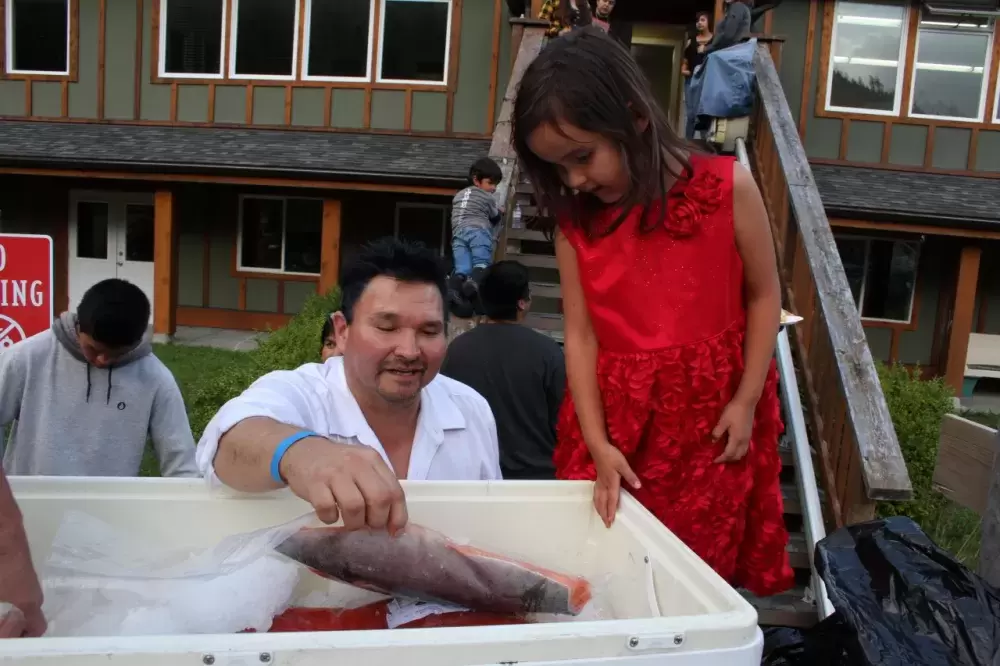A growing collection of evidence is pointing to the lost nutritional benefits of a traditional First Nations diet that was sustained before the transition to processed foods, according to a presentation given to Nuu-chah-nulth leaders in October.
With a reliance on fish, berries and plants in their immediate area, coastal Indigenous people relied on a diet high in protein, iron, fibre and omega-3 fatty acids, said dietician Rachel Dickens during her address at the Council of Ha’wiih Forum on Fisheries on Oct. 7.
“What research is showing now is that eating Indigenous customary foods can decrease or eliminate the risk of obesity, heart disease or diabetes,” she said.
Besides the sweetness of salmon berries, salal berries and highbush cranberries, before contact with industrialized European cultures, First Nations on the Pacific coast consumed a relatively low amount of sugar, explained Dickens. This was before the spread of processed food, and this traditional diet did not include refined flour that is now commonly used in pastries and white bread. Seafood was a fundamental part of the traditional diet, including a diversity of salmon and shellfish, complimented by things like herring and seagull eggs, which can be found in the spring in Nuu-chah-nulth territory.
“We know that traditional foods can help stave off the development diabetes and other ailments that did not exist in traditional Indigenous societies prior to contact,” said Dickens. “We also know that there is a high importance to accessing traditional foods because there is a link to culture and its importance to physical, emotional, psychological and spiritual well-being.”
A study released in December from the First Nations Health Authority and the Office of the Provincial Health Officer shows a 10 per cent rate of diabetes among the province’s Indigenous people, compared to eight per cent for the rest of B.C.’s population.
Obesity is also higher among Aboriginal people, according to wide-ranging analysis conducted by Statistics Canada. The Aboriginal Peoples Survey released in 2006 shows that 26.6 per cent of off-reserve Indigenous adults were obese, while 18.8 per cent of children aged 6-14 suffered from the same condition. The on-reserve rates are even higher, as the First Nations Regional Longitudinal Health Survey from 2002-03 reported 36 per cent of adults who were obese, with even higher rates among children under 9. Statistics Canada has the national obesity rate at 22.7 per cent.
The rates of these chronic conditions could be a factor in lower life expectancy among Aboriginal people in the province. The average Indigenous person is expected to live to 73 – 10 years less than the rest of B.C., reports the FNHA.
The Centre for Traditional Medicine draws a link between the loss of the pre-contact diet and the spread of chronic disease among many Indigenous people in Canada.
“There is a direct relationship between the loss of traditional foods and limited access to these foods and the increase of chronic illnesses including diabetes, as well as depression, and cardiovascular (heart) disease,” said the centre’s research director Dr. Leslie Korn in a report.
Part of the reason for this could be the high presence of protein and iron in wild fish and meat, while such food has lower concentrations of saturated fat than in farmed animals.
Dickens said iron is particularly important for small children and pregnant or young women, who face a higher risk of iron deficiency. Traditionally, the consumption of Vitamin C in berries helped iron intake.
“Vitamin C is extremely important for the absorption of iron,” Dickens explained. “Iron deficiency is prevalent in the community, especially amongst Nuu-chah-nulth women.”
Her presentation also highlighted the health benefits of fish. The high presence of omega-3 fatty acids helps fight inflammatory diseases, while Vitamin D boosts immunity.
“The oil in fish is also really high in Vitamin D,” Dickens said. “Vitamin D is especially important in our communities because it comes from the sun, and from October to March we don’t get enough from the sun. Historically we would get Vitamin D from blubber and lots of fats, which we don’t have a whole lot of in our diet anymore.”
But accessing such nutritional food can be difficult, particularly for those in urban areas far from the resources of their ancestral territory, cautioned Matilda Atleo, a health promotion worker with the Nuu-chah-nulth Tribal Council.
“It’s not all accessible to everyone – especially the away-from-home family members,” she said during the Oct. 7 presentation, noting that this was a difficult year for fish.
To protect endangered chinook salmon that originated from the Fraser River, First Nations access to fish for food, social and ceremonial purposes was limited in 2019.
“For this year there wasn’t very much salmon,” added Atleo. “I think I just received one big salmon and that was it for this year.”







